World Vegetation Area
Outdoor
Evergreen Broad-leaved Forest
Trees that grow in evergreen broad-leaved forests have shiny leaves. This section features coastal forests of Camellia japonica, Castanopsis sieboldii, and Machilus thunbergii; and inland forests of Quercus glauca, Quercus myrsinaefolia and Quercus acuta. Ardisia crenata and ferns such as Arachniodes aristata and Polystichum polyblepharum make up the herbaceous layer of the coastal forests, while Polystichum longifrons, Cephalanthera falcata and Cephalanthera longibracteata can be seen on the floor of the inland forests.
 Castanopsis sieboldiiandMachilus thunbergiiforest with a herbaceous layer of Arachniodes aristata (photo taken in late August)
Castanopsis sieboldiiandMachilus thunbergiiforest with a herbaceous layer of Arachniodes aristata (photo taken in late August)
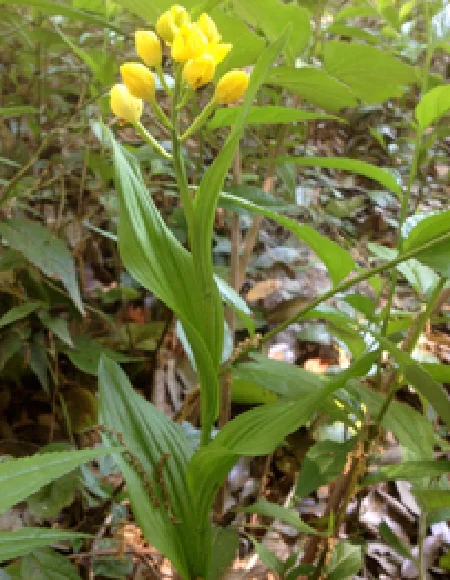 Cephalanthera falcata
Cephalanthera falcata A plant that parasitizes fungi symbiotic with broadleaf trees, blooming around May.
Temperate Coniferous Forest
Temperate coniferous forests are mainly comprised of fir, hemlock, hinoki cypress and cedar trees, and are found in humid regions at altitudes of 500-1,000 meters above sea level. The forest floor is usually dark, but where the light intensity has locally
increased around a fallen tree caused by a typhoon or other factors, flowers such as azaleas bloom. Therefore, enhancing the biodiversity of the forest.
You can see different varieties of coniferous trees, as well as flowers such as Cypripedium japonicum in this section. A coniferous species, Sciadopitys verticillata, native to the Kii Peninsula and the Shikoku region, is endemic to Japan
and it is the sole species of the family Sciadopityaceae.
 Rhododendron dilatatum and other understory plants grow in an opening between fir trees
Rhododendron dilatatum and other understory plants grow in an opening between fir trees
(photo taken in late August)
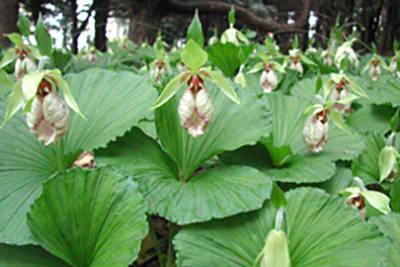 Cypripedium japonicum is said to resemble the figure of Kumagai Naozane, a samurai from the Kamakura period. It blooms around April to May.
Cypripedium japonicum is said to resemble the figure of Kumagai Naozane, a samurai from the Kamakura period. It blooms around April to May.
Warm-temperate Deciduous Broad-leaved Forest
Warm-temperate deciduous broad-leaved forest scenery is typical in rural Japan. The seeds of such trees germinate easily, and lead to rapid forest regeneration where evergreen trees have been cut. Therefore these trees have been useful as fuel resources. Typically, structured vegetation have developed with, for example, Celtis sinensis, Quercus acutissima, Quercus serrata, and Prunus jamasakura in the tree layer; Callicarpa japonica, Viburnum dilatatum, and Clethra barbinervis in the understory; and Erythronium japonicum and Anemone flaccida in the herbaceous layer. Sunlight filters down to the forest floor in the spring, and characteristic plants including so-called "spring ephemerals" can be seen in bloom.
 Prunus jamasakura forest withCorylus heterophyllavar.thunbergii (hazel) and Callicarpa japonica in the understory (photo taken in late August)
Prunus jamasakura forest withCorylus heterophyllavar.thunbergii (hazel) and Callicarpa japonica in the understory (photo taken in late August)
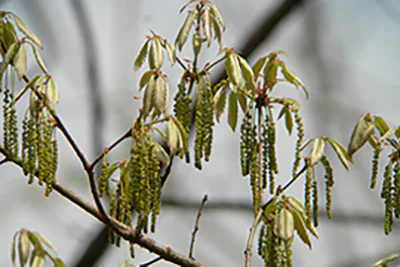 Anemophilous flower ofQuercus serrata(photo taken in mid April)
Anemophilous flower ofQuercus serrata(photo taken in mid April)
The drooping parts are the male inflorescences that disperse large amounts of pollen.
Cool-temperate Deciduous Broad-leaved Forest
Cool-temperate deciduous broad-leaved forests are found, for example, on the mountains in the Chubu region of Japan (called the Fagus crenata zone), at an altitude of 800-1,600 meters. The tree layer comprises of deciduous trees such as Fagus crenata, Fagus japonica, Quercus crispula, and various maple species. The forest floor is bright enabling azaleas to grow in the understory, and an herbaceous layer that is rich in plant diversity. There is a small stream toward the inner part where you can see several endemic plants of Japan such as Anemonopsis macrophylla and Ranzania japonica that favor cool and moist environment.
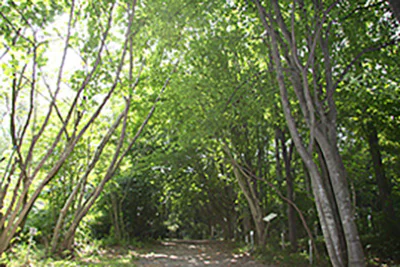 A tunnel created byFagus crenata(photo taken in July)
A tunnel created byFagus crenata(photo taken in July)
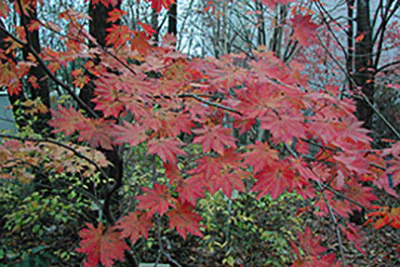 Leaves of Acer japonicum turn color in the autumn (photo taken in late November)
Leaves of Acer japonicum turn color in the autumn (photo taken in late November)
Scrub (Lowland, Highlan)
Scrub forests are found in the sunny verge of forest, rocky and wind-beaten areas ranging from warm-temperate (low altitude areas) to cool-temperate (high altitude areas) zones, and also in areas where forests have been cleared. Most plants in scrub forests
are insect-pollinated (entomophilous), while in stable climax forests, the dominant trees such as beeches, oaks, and coinifers are mainly wind-pollinated (anemophilous).
Plants in this section include Stephanandra incise, an endemic species from the fossa magna region around Mt. Fuji. This species is considered to be derived from Stephanandra tanakae, a species grows over a wide area.
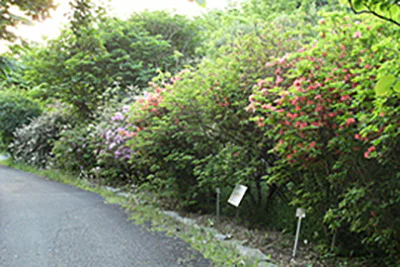 Entomophilous flowersRhododendron kaempferi(red) andR. macrosepalum(pink) of warm-temperate zones
Entomophilous flowersRhododendron kaempferi(red) andR. macrosepalum(pink) of warm-temperate zones
(photo taken in early May)
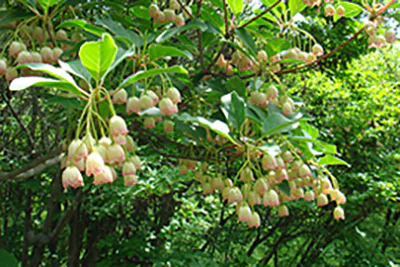 Enkianthus campanulatusof cool-temperate zones
Enkianthus campanulatusof cool-temperate zones
(photo taken in mid-May)
Sand and Gravelly Area (Mountain)
Plants native to mountain riverbeds where grit and pebbles accumulate due to flooding have been planted. A small stream runs along the paths, where visitors can observe vegetation characteristic of mountain streams and spring-fed wetlands.
Sand and Gravelly Area (Seaside)
Plants that naturally grow on sandy beaches and can withstand harsh environmental conditions—such as strong sea winds, shifting sands, intense sunlight, and sea spray—have been planted. Occasionally, the sand is stirred to recreate the disturbed coastal environment.
YouTube [Official Account of the National Museum of Nature and Science] Kahaku Channel
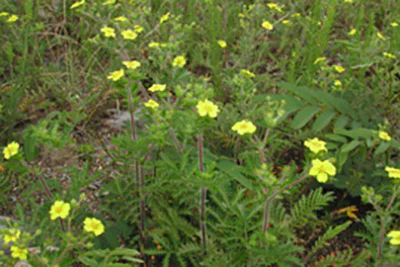 Potentilla chinensis community in a relatively stable riverbed environment (photo taken in late July)
Potentilla chinensis community in a relatively stable riverbed environment (photo taken in late July)
 Vitex rotundifolia, Scutellaria strigillosa and Juniperus conferta that grow in the sandy area (photo taken in late August)
Vitex rotundifolia, Scutellaria strigillosa and Juniperus conferta that grow in the sandy area (photo taken in late August)
Mountain Grassland (Lowland, Highland)
Mountain grasslands are found in wind-beaten areas, arid volcanic areas, deforested areas, and grazing pastures in regions ranging from warm-temperate (low altitude areas) to cool-temperate (highland areas) zones. Pulsatilla cernua, Primula sieboldii (primrose) and other endangered varieties are among the plants that grow here. In the low altitude area, autumnal herbs such as Lespedeza bicolor, Platycodon grandiflorus and Patrinia scabiosaefolia grow in fields of Miscanthus sinensis.
 Patrinia scabiosaefolia, an autumnal herb of seven kinds (photo taken in early September)
Patrinia scabiosaefolia, an autumnal herb of seven kinds (photo taken in early September)
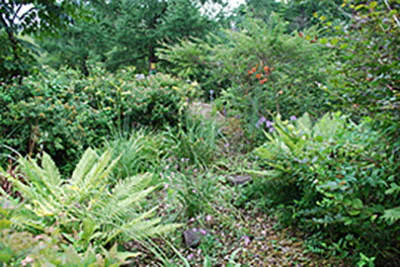 Osmundastrum cinnamomeum,Spiraea japonica
Osmundastrum cinnamomeum,Spiraea japonica
andHemerocallis thunbergiithat grow in the arid volcanic area (photo taken in early August)
Rockery Area (outdoor)(Mountain, Seaside)
The Japanese archipelago is covered by many steep mountains. There are many rocky areas in the country, as seen in coastal cliffs, banks of mountain streams, landslide scars of alpine and subalpine belts, and marginally forested areas, that are home to
many unique plants. The plants grow with their roots attached firmly to the rocks. Although they are small in size, most of these plants produce distinctive flowers. In the area simulating a rocky seacoast numerous autumnal flowers bloom, including Hemerocallis
fulva var. littorea and Nipponanthemum nipponicum. In the mountainous area, one can enjoy seasonal flowers such as Shibateranthis pinnatifida in February, Rosa hirtula in May, and Thymus quinquecostatus in
the summer.
YouTube [Official Account of the National Museum of Nature and Science] Kahaku Channel
YouTube [Official Account of the National Museum of Nature and Science] Kahaku Channel
 Hemerocallis fulvavar.littoreaandCyrtomium falcatumin the coastal area (photo taken in early September)
Hemerocallis fulvavar.littoreaandCyrtomium falcatumin the coastal area (photo taken in early September)
 Plants that grow on the rocks alongside mountain streams in the mountainous area (photo taken in late August)
Plants that grow on the rocks alongside mountain streams in the mountainous area (photo taken in late August)
Aquatic Plants Area
This section features plants that grow in natural aquatic environments. Various aquatic plants are cultivated in the five zones : swamp forest in the mountain (Japanese primrose), marsh in the highland (Water shield), paddy field and reservoir pond (Japanese water clover), marsh in the lowland (Floating heart), and swamp in the alpine region (Japanese water lily).
 Aquatic plants area
Aquatic plants area
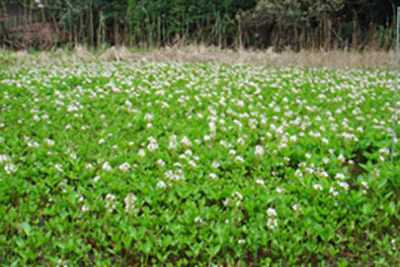 Menyanthes trifoliata
Menyanthes trifoliata Native to cool-temperate wetlands.(photo taken in May)
Indoor
Savanna House (America, Africa, and Australia District)
Savannas are characterized by distinct dry and rainy seasons and little precipitation in dry season. In such regions the plants have several characteristic features to withstand dry periods. The plants in the greenhouse include cacti and agave in American zone; aloe, baobab, and succulent plants of Euphorbia in African zone; and Eucalyptus, Callistemon speciosus (bottlebrush), and Proteaceae in Australian zone. Many plants of Cycadaceae are also seen in the house.
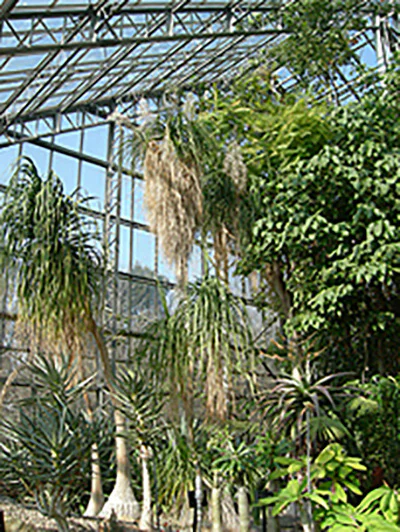 Beaucarnea recurvata. The swollen base of the stem serves to store water
Beaucarnea recurvata. The swollen base of the stem serves to store water
(photo taken in February).
 Euphorbia enopla. The plant has a close resemblance to cacti in appearance, and that is one example of morphological convergence to dry vegetation
Euphorbia enopla. The plant has a close resemblance to cacti in appearance, and that is one example of morphological convergence to dry vegetation
(photo taken in June).
Tropical Rainforest House(lowland rainforest・mountain rainforest)
*We are making the "Tropical Rainforest House 1st Floor lowland rainforest exhibit room" publicly available.
*We are making the "Amorphophallus titanum bloom records" publicly available.
The greenhouse is divided into two sections, one resembling low altitude rainforests, and the other simulating mountain rainforests of Southeast Asia. The section of Low Altitude contains tall trees of Dipterocarpaceae, Moraceae, and Arecaceae, and various epiphytes, climbers and other plants. The section of High Altitude includes plants of Fagaceae and Theaceae, Rhododendron, orchids, ferns and carnivorous plants.
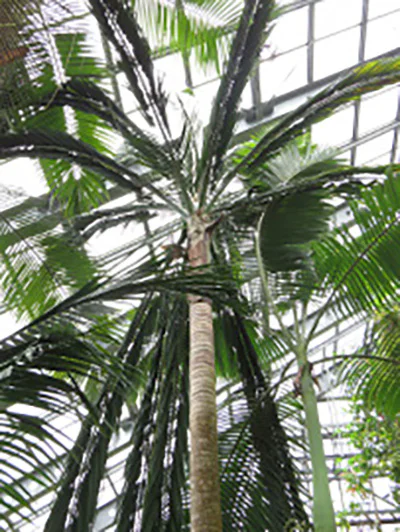 Satakentia liukiuensis. The palm tree is endemic to Ishigaki and Iriomote islands in Japan.
Satakentia liukiuensis. The palm tree is endemic to Ishigaki and Iriomote islands in Japan.
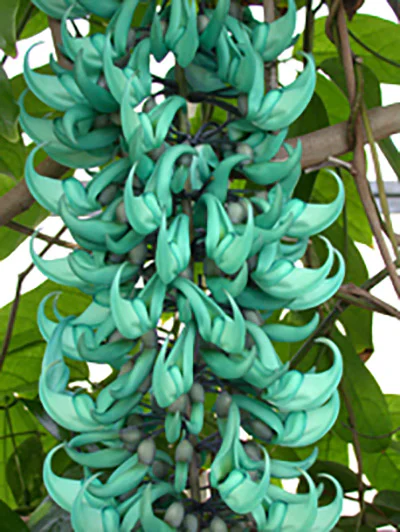 Jade vine (Strongylodon macrobotrys). The jade flowers are considered to attract bats as pollinators.
Jade vine (Strongylodon macrobotrys). The jade flowers are considered to attract bats as pollinators.
Aquatic Plants House (Freshwater, Mangroves)
You can also observe how aquatic plants have adapted themselves to the many types of water environments.
Tropical Aquatic Plants Room: Plants that grow in rivers, lakes and swamps of subtropical to tropical regions. Visitors can observe the unique adaptations made by aquatic plants to suit their living environment.
Mangrove Plants Room: Mangrove trees that grow on raised coral reefs are displayed here.
Aqua Slope: The exhibits show the pollination systems of aquatic plants using insect, wind and water.
YouTube [Official Account of the National Museum of Nature and Science] Kahaku Channel
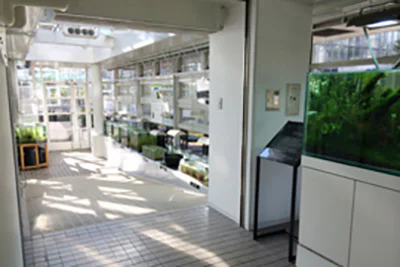 Aqua Slope. Diverged pollination systems are exhibited.
Aqua Slope. Diverged pollination systems are exhibited.
 Tropical Aquatic Plants Room. The large plant on the right back isTyphonodorum lindleyanum, native to Madagascar (photo taken in August)
Tropical Aquatic Plants Room. The large plant on the right back isTyphonodorum lindleyanum, native to Madagascar (photo taken in August)
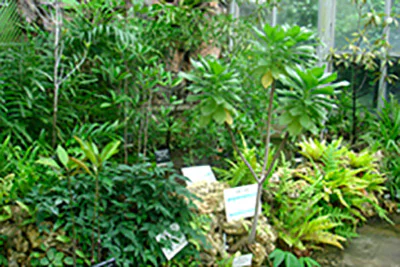 Mangrove Plants Room. Southeast Asian Mangrove trees (Bruguiera gymnorhiza,Rhizophora mucronata, and others), and raised coral reef plants (Heliotropium foertherianum,Asplenium setoi, and others)
Mangrove Plants Room. Southeast Asian Mangrove trees (Bruguiera gymnorhiza,Rhizophora mucronata, and others), and raised coral reef plants (Heliotropium foertherianum,Asplenium setoi, and others)
Around House
Around House
Numerous herbs and bulbous plants that grow in the Mediterranean climate, marked by dry summers and humid winters, are displayed in the area surrounding the Savanna House. Trees of Fagaceae, Lauraceae, Theaceae, and Ericaceae from Southern China, which are relative to Japanese warm-temperate trees, are planted around the Tropical Rainforest House.
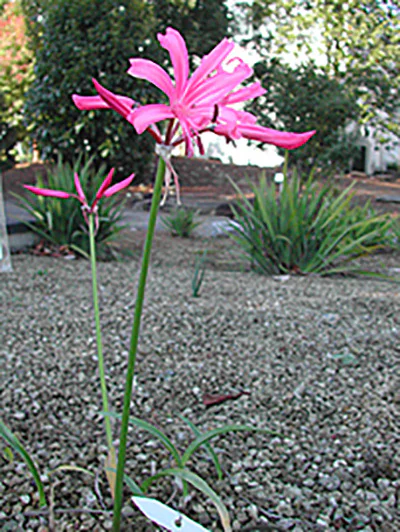 Nerine bowdenii. Mediterranean plants are planted around the Houses (photo taken in late November).
Nerine bowdenii. Mediterranean plants are planted around the Houses (photo taken in late November).
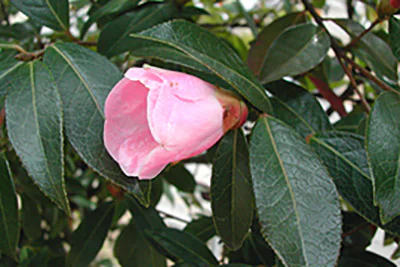 Camellia saluenensisfrom Southern China grown outside the Houses (photo taken in early March).
Camellia saluenensisfrom Southern China grown outside the Houses (photo taken in early March).